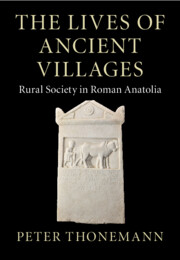Book contents
- The Lives of Ancient Villages
- Greek Culture in the Roman World
- The Lives of Ancient Villages
- Copyright page
- Contents
- Figures
- Tables
- Preface
- Abbreviations
- Maps
- 1 Hieradoumia
- 2 Commemorative Cultures
- 3 Demography
- 4 Kinship Terminology
- 5 Household Forms
- 6 The Circulation of Children
- 7 Beyond the Family
- 8 Rural Sanctuaries
- 9 Village Society
- 10 City, Village, Kin-Group
- References
- Index
8 - Rural Sanctuaries
Published online by Cambridge University Press: 28 October 2022
- The Lives of Ancient Villages
- Greek Culture in the Roman World
- The Lives of Ancient Villages
- Copyright page
- Contents
- Figures
- Tables
- Preface
- Abbreviations
- Maps
- 1 Hieradoumia
- 2 Commemorative Cultures
- 3 Demography
- 4 Kinship Terminology
- 5 Household Forms
- 6 The Circulation of Children
- 7 Beyond the Family
- 8 Rural Sanctuaries
- 9 Village Society
- 10 City, Village, Kin-Group
- References
- Index
Summary
This chapter reconstructs the typical physical form of the rural sanctuaries of Roman Hieradoumia, as well as their landholdings and distinctive labour regimes. The exiguous evidence from excavations and surveys is set alongside a lengthy inscription from a sanctuary of Apollo Kisauloddenos that describes the sacred buildings and their associated furniture. The mechanisms by which these sanctuaries accumulated their large landholdings are discussed, with a focus on the evidence for semi-compulsory ‘tithes’ on secular land-transactions. Sacred woodlands and groves were a standard feature of sanctuaries’ landholdings, and poaching from these woodlands was very widespread. Although these sanctuaries had a small permanent staff of sacred officials, much of the rural labour on their estates was provided through the Hieradoumian institution of ‘sacred slavery’, under which villagers were expected to offer their labour as hierodouloi for a fixed term of service. Low-level resistance to this compulsory labour service was endemic, illustrating the structural tensions that existed between Hieradoumian villagers and the powerful sanctuaries of the region.
- Type
- Chapter
- Information
- The Lives of Ancient VillagesRural Society in Roman Anatolia, pp. 241 - 283Publisher: Cambridge University PressPrint publication year: 2022

